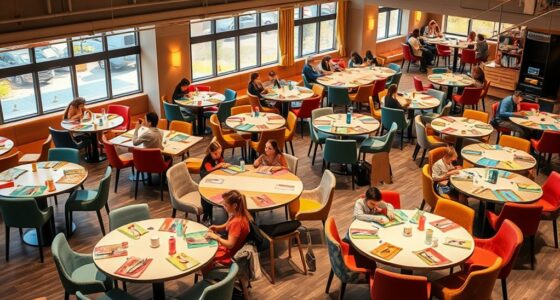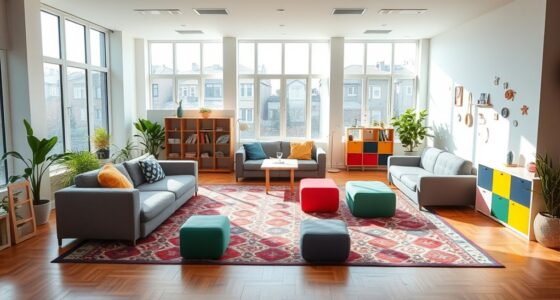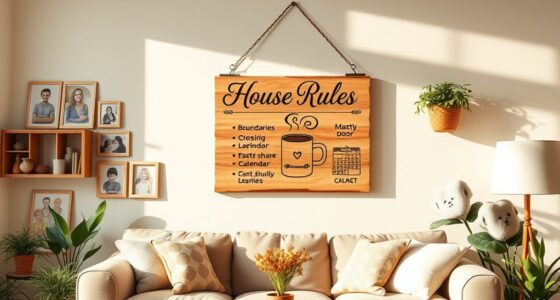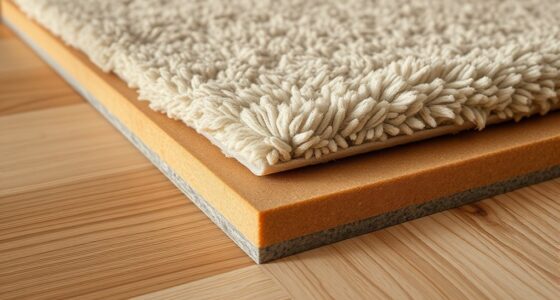Designing outdoor spaces for all ages involves combining versatile amenities like playgrounds, open lawns, and quiet zones, ensuring safety and accessibility. Use impact-absorbing surfacing and integrate shaded areas to keep everyone comfortable. Place seating and communal features strategically to promote social interaction. Incorporate inclusive elements such as ramps and sensory gardens for children with diverse needs. If you continue exploring, you’ll discover how to create welcoming, functional spaces that serve your community’s entire range of needs.
Key Takeaways
- Design flexible zones combining playgrounds, open lawns, and quiet areas to serve diverse age groups and activities.
- Incorporate accessible pathways, ramps, and sensory elements to ensure inclusivity for children and adults with disabilities.
- Use safety-compliant equipment and impact-absorbing surfaces, with regular inspections to maintain a secure environment.
- Add shaded seating, picnic areas, and community spaces to promote social interaction and comfort in all weather conditions.
- Integrate natural landscape features, such as native plants and noise buffers, to create a peaceful, inviting outdoor environment for everyone.
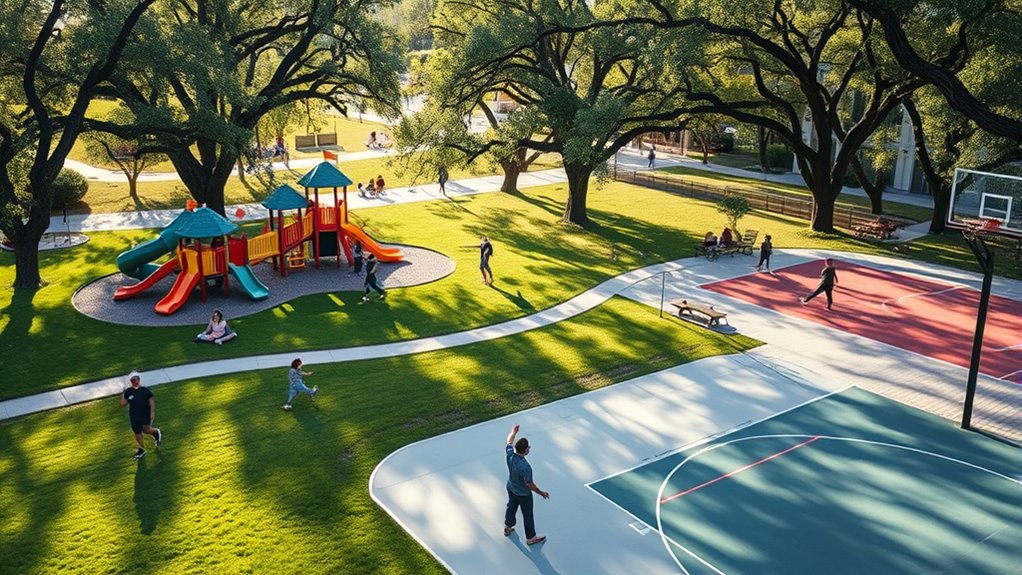
Creating outdoor spaces that cater to all ages enhances community well-being and encourages active lifestyles. When designing these areas, you want to focus on safety and thoughtful landscape design to guarantee everyone can enjoy them comfortably and confidently. Playground safety is a critical aspect, especially when kids are involved. You need to select equipment that meets safety standards, like impact-absorbing surfaces beneath swings and slides, to minimize injuries. Regular inspections are essential to identify and fix hazards such as broken equipment or loose fixtures. It’s also wise to include shaded areas to protect children from sun exposure, and to design pathways that are clearly marked and accessible for strollers or wheelchair users. These steps help create a secure environment where families can relax and play without worry.
At the same time, landscape design plays a crucial role in shaping inviting, multifunctional outdoor spaces. Incorporate diverse elements such as open lawns for sports, quiet zones for reading or picnicking, and nature trails for exploration. Using native plants not only enhances the aesthetic appeal but also reduces maintenance and supports local ecosystems. Thoughtful placement of seating areas encourages social interaction among different age groups, whether it’s grandparents watching grandchildren or neighbors chatting over coffee. Adding features like benches, picnic tables, and shaded pavilions makes the space more usable throughout the day and in various weather conditions. Additionally, understanding the importance of fostering community engagement can help in designing spaces that promote interaction and inclusivity for everyone involved.
To make the space truly inclusive, consider the needs of all users. Incorporate accessible features such as ramps, tactile guides, and sensory gardens that engage children with different abilities. When planning the layout, keep sightlines open so that parents and caregivers can easily supervise their children from multiple vantage points. Good landscape design also considers noise reduction; planting trees and shrubs can buffer sounds from nearby roads or busy streets, creating a peaceful environment. Lighting is another key element, ensuring the space is safe and usable after dark.
Frequently Asked Questions
How Can I Ensure Accessibility for Disabled Visitors?
You can guarantee accessibility for disabled visitors by designing adaptive pathways that accommodate wheelchairs and mobility devices, making navigation seamless. Incorporate sensory-friendly design elements like calming colors, quiet zones, and textured surfaces to cater to visitors with sensory sensitivities. Regularly consult with disability advocates to identify specific needs and update your space accordingly. This proactive approach creates an inclusive environment where everyone can enjoy the outdoor space comfortably and safely.
What Materials Are Best for Weather-Resistant Outdoor Furniture?
Ever wondered what materials stand up to the elements best? You should choose outdoor furniture made from weatherproof fabrics and corrosion-resistant metals. These materials resist rain, sun, and rust, ensuring longevity. Teak and aluminum are excellent options, as they’re durable and low-maintenance. By selecting these materials, you create a space that remains inviting and functional year-round, regardless of weather conditions. Wouldn’t you want furniture that lasts through every season?
How Do I Incorporate Safety Features for Children and Seniors?
You should incorporate safety features by child-proofing the space with rounded edges, secure fencing, and non-slip surfaces. For seniors, prioritize senior-friendly design with ramps, comfortable seating, and adequate lighting. Guarantee play areas are away from hazards and use soft ground coverings. Regularly inspect equipment and surfaces to prevent accidents. Combining child-proofing and senior-friendly elements creates a safe, inclusive outdoor environment where everyone can enjoy comfortably and confidently.
What Is the Ideal Lighting for Multi-Use Outdoor Spaces?
Imagine a gentle glow that invites everyone to linger, creating a warm, welcoming atmosphere. You should use ambient lighting with energy-efficient fixtures, providing just enough illumination for safety and comfort without overpowering the natural surroundings. Opt for soft, evenly distributed lights that highlight pathways and gathering areas, ensuring all ages feel secure and relaxed. This balanced approach transforms your outdoor space into a versatile haven for fun and relaxation after sunset.
How Can I Create Inclusive Seating Options for Different Needs?
You can create inclusive seating options by incorporating ergonomic benches and adjustable chairs to meet diverse needs. Place benches with armrests and varied heights to support comfort and accessibility, while adjustable chairs allow users to customize their seating. Guarantee pathways are wide enough for mobility aids and include seating areas at different levels. This approach guarantees everyone feels welcome and comfortable, fostering an inclusive outdoor environment.
Conclusion
So, next time you design an outdoor space, remember—it’s not just about keeping kids busy or adults relaxed. Ironically, the best spaces are those that serve everyone, yet somehow become the most overlooked. Imagine a place where you can chase your kids, relax with friends, or simply enjoy solitude—yet, it’s often the one thing missing from your backyard. Truly, the most versatile outdoor space is the one you never thought you’d need.


